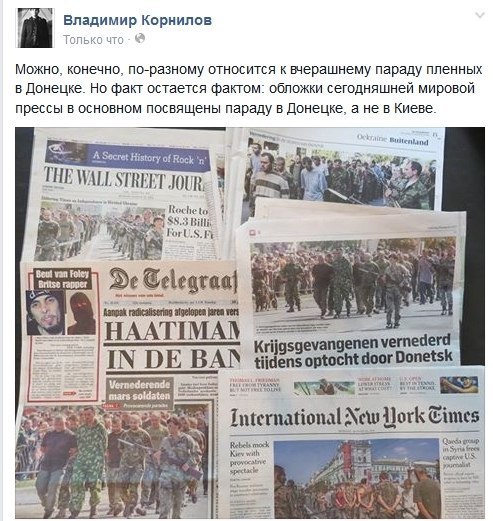Donetsk rebels march Junta prisoners in a mock parade designed to spoil Kiev’s jingoistic celebrations.

[A]s Ukraine marked its Independence Day on Sunday with a military march in Kiev, pro-Moscow rebels countered by parading captured Ukrainian troops through the streets in Donetsk’s central Lenin Square.
Translation:
Vladimir Kornilov
Of course, all of us can have different opinions on the yesterday’s prisoner parade in Donetsk. But it is a matter of fact that the front pages of today’s world press are mostly dedicated to the parade in Donetsk and not to the one in Kiev.
This is how the victories in information war are done. It was enough to show a few prisoners and march them where it was needed and the junta’s holiday was hopelessly spoiled.
SOURCE: http://cassad-eng.livejournal.com/71125.html
APPENDIX
Below, the way the event was reported by a major Western newspaper, The US-based Christian Science Monitor. The CSM stands out for its relatively even-handed way of covering this type of news. The New York Times is far more biased and insidious. —Eds
In Ukraine, competing parades as east-west divisions deepen
Pro-Moscow separatists paraded Ukrainian prisoners of war in Donetsk to the delight of cheering crowds today, as Kiev celebrated independence with a rare military parade in the capital.
DONETSK, UKRAINE
The dozens of captive Ukrainian soldiers moved down the main drag of this eastern rebel stronghold with their hands tied behind their back and their heads sunk low. Parallel rows of armed men ordered them to parade past the jeering crowds lining each side of the wide street.
“Fascists!” “Murderers!” “Get on your knees!” the crowd called as the captives shuffled past. Some were dressed in camouflage, others simply in t-shirts and short pants, and wearing nothing but plastic sandals. From the sidelines, the crowd tossed trash and water bottles at them. The soldiers grimaced, but kept their eyes down.
The scene in central Donetsk was like something out of another time, specifically toward the end of WWII, when the Soviet Army marched 65,000 German POWs through the streets of Moscow and other cities of the USSR, including Kiev.
This time the humiliated prisoners of war aren’t part of an invading Nazi war machine, but members of Ukraine‘s national army. The self-declared Donetsk People’s Republic, which organized the display, described the men as accomplices in the Kiev “junta’s” war against Eastern Ukrainians seeking federation with Russia.
“Let the scum see what they have done to the Donbas people,” says Marharitta, a pensioner who along with about 1,000 others had come to see the procession. She declined to give her full name, in case the Kiev “fascists” were to come and arrest her. “You think their mothers will be proud of them now?”
The public humiliation of the Ukrainian POWs was meant to counter a very different kind of parade happening about 400 miles away in the Ukrainian capital today, where President Petro Poroshenko hosted an Independence Day event that included some 1,500 active service men and dozens of new tanks, missile launchers and other heavy artillery weapons.
It was the first time Ukraine had had a military parade in the capital since 2009. At the end of the parade, the military equipment and the soldiers were scheduled to be sent out east to the front lines of an ongoing conflict here that has cost more than 2,000 lives and threatens to tear the country apart.
The Kiev parade occurred on the Maidan – the very square where, last November, thousands of protestors gathered to protest then President Viktor Yanukovych’s back peddling on signing a European Union association agreement. Those demonstrations led to the pro-Moscow leader’s ouster, and, eventually, Russia’s annexation of the Crimea peninsula and the pro-Russia uprising in much of the east.
Mr. Poroshenko warned Ukrainians that despite 23 years of independence, the current conflict had shown that “in the foreseeable future there will always, unfortunately, be the threat of war.”
“We not only have to learn to live with that. We must always be prepared to defend our independence,” Poroshenko said.
Today, the center of Donetsk is the focal point in this embattled region as a western-leaning Kiev government struggles for the fourth violent month to overtake the pro-Russia separatists, whom have declared Donetsk and the neighboring Luhansk region independent from the rest of Ukraine.
The conflict has displaced more than 300,000 fleeing in the east, according to the latest figures from the United Nations. The civilian death toll continues to rise, and the humanitarian crisis is deepening in Luhansk, where the city’s remaining 200,000 residents have not had water or electricity for more than 20 days.
The Geneva Convention prohibits publicly humiliating POWs. But Sunday’s event is not the first time either side of this conflict has been accused of violations. Human Rights Watch has accused both sides of war crimes, including the use of heavy artillery in civilian areas.
The Ukrainian army has now all but surrounded the city of Donetsk, and explosions from heavy artillery shelling can be heard in the city center. On Sunday morning, mortar rounds crashed into the Kalinina Hospital and its morgue, just a quarter of a mile from the city center. No one was killed, but doctors and nursessaid they scrambled to get as many patients as possible to safety.
In the damp and musky basement of the oncology ward, Olga Romanenko, 66, was sitting alone on a chair; waiting out the hours until the shelling was over. The breast cancer survivor was too weak to climb the dilapidated stairs to the makeshift bomb shelter.
“When in the history of this world have Ukrainians ever killed each other?” she says. “We just want them to stop shooting. I want my a normal life back.”
As another rapid succession of artillery fire set off in the distance, Mrs. Romanenko placed her head in the palm of her hand and began to cry. “There is no reason for this. There is no reason for this fighting,” she said.



